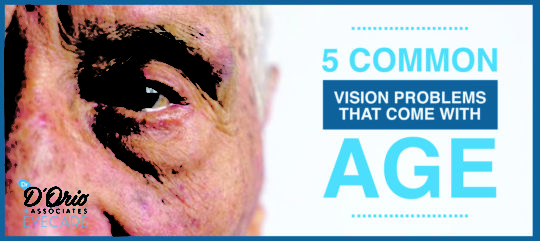
30 Aug 5 COMMON VISION PROBLEMS THAT COME WITH AGE
“In the years after you turn 60,” states the American Optometric Association“a number of eye diseases may develop that can change your vision permanently. The earlier these problems are detected and treated, the more likely you can retain good vision.
We all know what happens when you get older; your body begins to break down. This is especially true when it comes to your vision.
There is a bright side…. By engaging in a healthy active lifestyle, you can delay these problems from really impacting your life. But, it is also important to be aware and conscious of what these common vision problems can do to you later in life.
1. Age Related Macular Degeneration
Age Related Muscular Degeneration or (AMD) is the leading cause of severe vision loss in those over 50, and results in the loss of central vision. Symptoms include the gradual loss of ability to see objects clearly; distortion of objects and shapes; loss of clear color vision, and a dark or empty area in the center of vision.
2. Blepharitis
This disease is an inflammation or infection of the eyelid, and it can lead to similar symptoms as dry eye. Some symptoms include: irritated, itchy eyelids and the formation of dandruff-like scales on the eyelashes. Although it can be uncomfortable to deal with, it’s not usually contagious and doesn’t generally lead to vision damage.
3. Cataracts
This disease is very dangerous. A cataract is a cloudy or opaque area in the lens of the eye that can interfere with vision. They are most commonly found in older adults, and they are the most common cause of blindness.
According to Prevent Blindness America, about 24.5 million U.S. adults over 40 have cataracts. Symptoms include blurred or hazy vision, increased difficulty seeing at night, increased sensitivity to glare and reduced intensity of colors.
4. Glaucoma
The second-leading cause of blindness is glaucoma. Glaucoma is actually comprised of a group of eye disorders. These disorders cause progressive damage to the optic nerve, ultimately resulting in loss of vision.
It is most common in people over the age of 40. The AOA recommends an annual eye exam for anyone at high risk for glaucoma: older adults, especially African-Americans and those with a family history of glaucoma.
5. Diabetic Retinopathy
Seniors are more likely to suffer from diabetes, and thus can be affected by diabetic retinopathy. It causes progressive damage to the retina, the light-sensitive lining at the back of your eye. Diabetic retinopathy is a serious sight-threatening complication rooted in diabetes.
Preventing Senior Vision Problems
Seniors can be proactive by simply eating a nutritious diet filled with plenty of leafy green vegetables, and by striving to keep blood pressure and diabetes under control.
Those in a higher risk group for vision problems may want to consider antioxidant supplements and eye health vitamins – the ones suggested by the California Optometric Association include: lutein and zeaxanthin, essential fatty acids, vitamins C and E, and zinc. These supplements will help strengthen your eyes.
For those who already suffering from vision loss, low-vision aids and devices can help, like CCTV and magnifiers. Our team of doctors are more than happy to help recommend you the right treatment for any of your vision problems.
Feel free to call usif you believe one of your loved ones may be suffering from some of these common age related vision problems. We would love to help.
[/bt_text][/bt_column][/bt_row][/bt_section]


